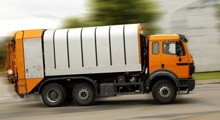STEP – online measurements for dispatching of waste disposal vehicles
In STEP, a prototype of a planning system will be developed and that uses online measurements from waste containers for the dispatching of waste disposal vehicles. Waste container measurements such as fill-level and temperature will be integrated into a mathematical planning-procedure to calculate and visualize optimal routes for daily, demand-driven waste disposal using large containers.

3.8 million tons of waste accumulate in Austria for private households alone. The project STEP will develop innovative methods to make the process of waste collection significantly more efficient by replacing the prevailing, static collection plans by a dynamic, demand-driven approach. Data concerning the fill-level of containers are partly already available – the challenge now is to utilize their unique advantages for the planning of collection-tours. Continuous data transmission and the integration thereof into a planning system make demand-driven container visits possible. Tour plans can then be optimized on a daily basis, allowing a dynamic response to the actual amount of waste and current obstacles such as building sites nearby. This will improve vehicle utilization and prevent empty trips. The consideration of sensor data alone can already help to reduce the amount of driven kilometres and thus reduce the burden on the environment. This effect can be improved by the use of tailored optimization techniques, which calculate the most efficient tours while considering all necessary constraints, and subsequently visualize the results.
The STEP-consortium is made up of experienced developers of optimization-processes with a lot of know-how in project management, GIS-specialists for the analysis and visualization of data, as well as experts from the waste-disposal industry and the developers of container-sensors. Together with the application-partners, who will test and give feedback for the planning-system prototype in the evaluation phase, STEP will realize the following goals:
- Collect and evaluate the online-sensor data from containers (position, fill-level, temperature, etc.)
- Model the problem, including the use of current data
- Develop and implement tailored procedures to calculate optimal collection-tours
- Develop the prototype of a planning-tool to support the daily planning of vehicle tours for waste collection
- Visualize the optimal routes
- Work together with potential users of the product to optimize the usability of the developed solution


